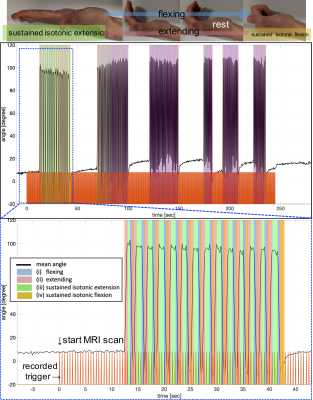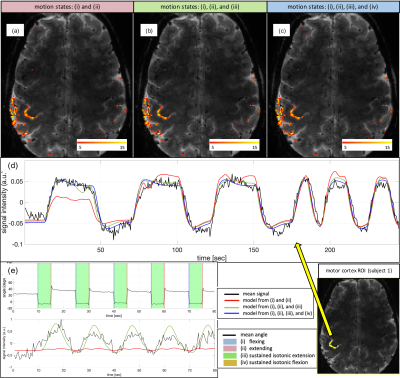Shota Hodono1,2, Donald Maillet1, Jin Jin2,3, David Reutens1,2, and Martijn A. Cloos1,2
1Centre for Advanced Imaging, The University of Queensland, Brisbane, Australia, 2ARC Training Centre for Innovation in Biomedical Imaging Technology, The University of Queensland, Brisbane, Australia, 3Siemens Healthcare Pty Ltd, Brisbane, Australia
1Centre for Advanced Imaging, The University of Queensland, Brisbane, Australia, 2ARC Training Centre for Innovation in Biomedical Imaging Technology, The University of Queensland, Brisbane, Australia, 3Siemens Healthcare Pty Ltd, Brisbane, Australia
We present a custom MR-compatible data glove to measure hand motion during concurrent fMRI of the human motor cortex at 7T without degradation of image quality. The ability to create subject-specific activation models enables a wide range of experimental paradigms with improved data quality.

Recorded hand motion during an fMRI scan. The bottom figure shows a zoomed view of the first section. Different motion states are highlighted in the figures. The trigger signal from the MR system is also shown in the figure (orange line).

Activation map of subject 1 obtained by GLM using motion states (a) (i) and (ii), (b) (i), (ii) and (iii), (c) (i), (ii), (iii) and (iv). 2d GRE-EPI sequence was used with following parameters; TR = 0.5sec, TE = 24.6ms, flip-angle = 40°, 1.1mm isotropic resolution, 18 slices, 143mm x 143mm FOV, GRAPPA = 3, MB = 2, 490 TRs. (d) Signal time series and model predictions of subject 1. (e) Recorded hand motion, signal timeseries and model predictions of subject 2. The mean signal time series calculated within motor cortex with Z>5. The figure legend on the bottom right applies for both (d) and (e).